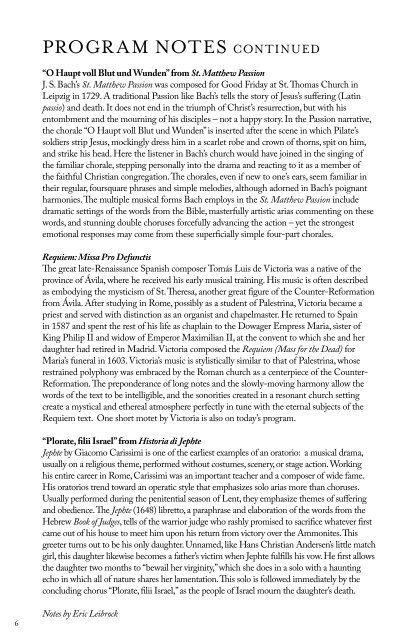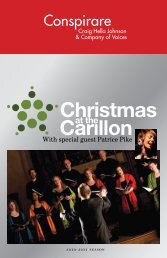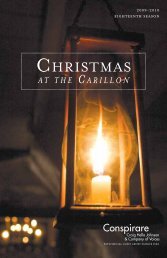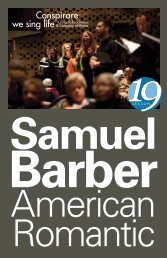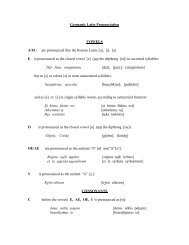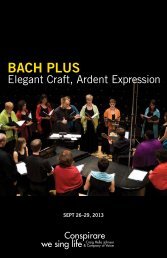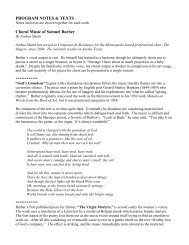The Mystic & the Storyteller - Conspirare
The Mystic & the Storyteller - Conspirare
The Mystic & the Storyteller - Conspirare
You also want an ePaper? Increase the reach of your titles
YUMPU automatically turns print PDFs into web optimized ePapers that Google loves.
PROGR AM NOTES continuED<br />
“O Haupt voll Blut und Wunden” from St. Mat<strong>the</strong>w Passion<br />
J. S. Bach’s St. Mat<strong>the</strong>w Passion was composed for Good Friday at St. Thomas Church in<br />
Leipzig in 1729. A traditional Passion like Bach’s tells <strong>the</strong> story of Jesus’s suffering (Latin<br />
passio) and death. It does not end in <strong>the</strong> triumph of Christ’s resurrection, but with his<br />
entombment and <strong>the</strong> mourning of his disciples – not a happy story. In <strong>the</strong> Passion narrative,<br />
<strong>the</strong> chorale “O Haupt voll Blut und Wunden” is inserted after <strong>the</strong> scene in which Pilate’s<br />
soldiers strip Jesus, mockingly dress him in a scarlet robe and crown of thorns, spit on him,<br />
and strike his head. Here <strong>the</strong> listener in Bach’s church would have joined in <strong>the</strong> singing of<br />
<strong>the</strong> familiar chorale, stepping personally into <strong>the</strong> drama and reacting to it as a member of<br />
<strong>the</strong> faithful Christian congregation. <strong>The</strong> chorales, even if new to one’s ears, seem familiar in<br />
<strong>the</strong>ir regular, foursquare phrases and simple melodies, although adorned in Bach’s poignant<br />
harmonies. <strong>The</strong> multiple musical forms Bach employs in <strong>the</strong> St. Mat<strong>the</strong>w Passion include<br />
dramatic settings of <strong>the</strong> words from <strong>the</strong> Bible, masterfully artistic arias commenting on <strong>the</strong>se<br />
words, and stunning double choruses forcefully advancing <strong>the</strong> action – yet <strong>the</strong> strongest<br />
emotional responses may come from <strong>the</strong>se superficially simple four-part chorales.<br />
Requiem: Missa Pro Defunctis<br />
<strong>The</strong> great late-Renaissance Spanish composer Tomás Luis de Victoria was a native of <strong>the</strong><br />
province of Ávila, where he received his early musical training. His music is often described<br />
as embodying <strong>the</strong> mysticism of St. <strong>The</strong>resa, ano<strong>the</strong>r great figure of <strong>the</strong> Counter-Reformation<br />
from Ávila. After studying in Rome, possibly as a student of Palestrina, Victoria became a<br />
priest and served with distinction as an organist and chapelmaster. He returned to Spain<br />
in 1587 and spent <strong>the</strong> rest of his life as chaplain to <strong>the</strong> Dowager Empress Maria, sister of<br />
King Philip II and widow of Emperor Maximilian II, at <strong>the</strong> convent to which she and her<br />
daughter had retired in Madrid. Victoria composed <strong>the</strong> Requiem (Mass for <strong>the</strong> Dead) for<br />
Maria’s funeral in 1603. Victoria’s music is stylistically similar to that of Palestrina, whose<br />
restrained polyphony was embraced by <strong>the</strong> Roman church as a centerpiece of <strong>the</strong> Counter-<br />
Reformation. <strong>The</strong> preponderance of long notes and <strong>the</strong> slowly-moving harmony allow <strong>the</strong><br />
words of <strong>the</strong> text to be intelligible, and <strong>the</strong> sonorities created in a resonant church setting<br />
create a mystical and e<strong>the</strong>real atmosphere perfectly in tune with <strong>the</strong> eternal subjects of <strong>the</strong><br />
Requiem text. One short motet by Victoria is also on today’s program.<br />
“Plorate, filii Israel” from Historia di Jephte<br />
Jephte by Giacomo Carissimi is one of <strong>the</strong> earliest examples of an oratorio: a musical drama,<br />
usually on a religious <strong>the</strong>me, performed without costumes, scenery, or stage action. Working<br />
his entire career in Rome, Carissimi was an important teacher and a composer of wide fame.<br />
His oratorios trend toward an operatic style that emphasizes solo arias more than choruses.<br />
Usually performed during <strong>the</strong> penitential season of Lent, <strong>the</strong>y emphasize <strong>the</strong>mes of suffering<br />
and obedience. <strong>The</strong> Jephte (1648) libretto, a paraphrase and elaboration of <strong>the</strong> words from <strong>the</strong><br />
Hebrew Book of Judges, tells of <strong>the</strong> warrior judge who rashly promised to sacrifice whatever first<br />
came out of his house to meet him upon his return from victory over <strong>the</strong> Ammonites. This<br />
greeter turns out to be his only daughter. Unnamed, like Hans Christian Andersen’s little match<br />
girl, this daughter likewise becomes a fa<strong>the</strong>r’s victim when Jephte fulfills his vow. He first allows<br />
<strong>the</strong> daughter two months to “bewail her virginity,” which she does in a solo with a haunting<br />
echo in which all of nature shares her lamentation. This solo is followed immediately by <strong>the</strong><br />
concluding chorus “Plorate, filii Israel,” as <strong>the</strong> people of Israel mourn <strong>the</strong> daughter’s death.<br />
TexTS AND TR ANSlATiONS<br />
O Haupt voll Blut und Wunden<br />
O Haupt voll Blut und Wunden, O Head full of blood and wounds,<br />
voll Schmerz und voller Hohn,<br />
full of pain and full of derision,<br />
O Haupt, zu Spott gebunden<br />
O Head, in mockery bound<br />
mit einer Dornenkron;<br />
with a crown of thorns,<br />
O Haupt, sonst schön gezieret<br />
O Head, once beautifully adorned<br />
mit höchster Ehr’ und Zier,<br />
with <strong>the</strong> most honour and adornment<br />
jetzt aber hoch schimpfieret:<br />
but now most dishonored:<br />
gegrüßet seist du mir!<br />
let me greet you!<br />
Du edles Angesichte,<br />
You noble countenance,<br />
dafür sonst schrickt und scheut before which once shrinks and cowers<br />
das große Weltgerichte,<br />
<strong>the</strong> great might of <strong>the</strong> world,<br />
wie bist du so bespeit!<br />
how you are spat upon!<br />
Wie bist du so erbleichet!<br />
How you are turned pallid!<br />
Wer hat dein Augenlicht,<br />
Who has treated those eyes<br />
dem sonst kein Licht nicht gleichet, to which no light is comparable<br />
so schändlich zugericht’?<br />
So shamefully?<br />
Requiem: Missa Pro Defuncto<br />
1. Introitus 1. Introit<br />
Requiem æternam dona eis, Domine, Eternal rest grant unto <strong>the</strong>m, O Lord,<br />
et lux perpetua luceat eis.<br />
and let perpetual light shine upon <strong>the</strong>m.<br />
Te decet hymnus Deus, in Sion, A hymn becomes you, O God, in Zion,<br />
et tibi reddetur votum in Ierusalem. and to you shall a vow be repaid in Jerusalem.<br />
Exaudi orationem meam;<br />
Hear my prayer;<br />
ad te omnis caro veniet.<br />
to you shall all flesh come.<br />
Requiem æternam dona eis, Domine, Eternal rest grant unto <strong>the</strong>m, O Lord,<br />
et lux perpetua luceat eis.<br />
and let perpetual light shine upon <strong>the</strong>m.<br />
2. Kyrie 2. O Lord<br />
Kyrie eleison;<br />
Lord have mercy upon us;<br />
Christe eleison;<br />
Christ have mercy upon us;<br />
Kyrie eleison<br />
Lord have mercy upon us.<br />
3. Graduale 3. Gradual<br />
Requiem æternam dona eis, Domine: Eternal rest grant unto <strong>the</strong>m, O Lord:<br />
et lux perpetua luceat eis.<br />
and let perpetual light shine upon <strong>the</strong>m.<br />
In memoria æterna erit justus, He shall be justified in everlasting memory,<br />
ab auditione mala non timebit.<br />
and shall not fear evil reports.<br />
Notes by Eric Leibrock<br />
6 7


